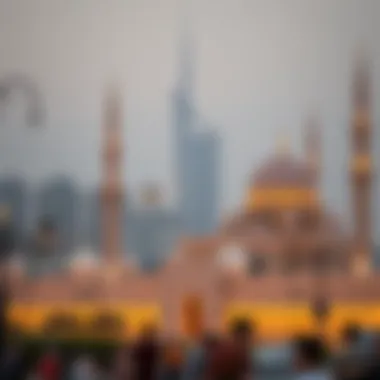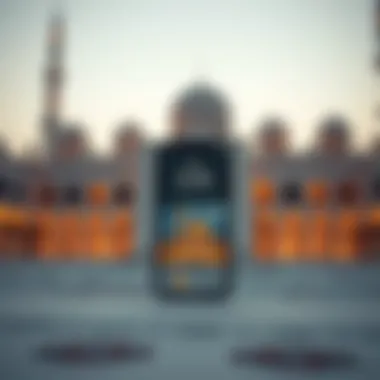Understanding Prayer Times in Dubai: A Complete Guide


Intro
Navigating the rhythm of daily life in Dubai means keeping an eye on the clock, especially when it comes to the five daily prayers of Islam. In a bustling metropolis known for its skyscrapers and luxury, the deeper layer of cultural practices comes to life through the observance of these important moments. Prayer times—determined through precise astronomical calculations—are more than simple routines; they embody the link between faith, community, and everyday life in this dynamic city.
Understanding how these times are calculated can uncover a wealth of insight into the social and religious fabric of Dubai. For residents and visitors alike, comprehension of prayer times facilitates respect for local customs, enhances social interactions, and aids in your own personal schedule during your time in the emirate. This guide promises to illuminate these intricacies, exploring the tools available for tracking prayer times as well as their resonance within both traditional and modern contexts.
The Importance of Prayer Time in Islam
In Islam, prayer is not just a ritual; it’s a lifeline connecting the believer to their Creator. Observing the five daily prayers, known as Salah, is fundamental in showcasing one's faith. Each prayer serves as a reminder of God’s presence throughout the day.
Understanding the Five Daily Prayers
The five daily prayers are Fajr, Dhuhr, Asr, Maghrib, and Isha. Each of these prayers has its own designated time, aligning closely with the natural rhythms of the day.
- Fajr is performed before dawn, symbolizing a fresh start and inviting peace.
- Dhuhr, the midday prayer, serves as a break in the hustle and bustle, grounding individuals back in their spiritual practice.
- Asr, which occurs in the late afternoon, is a reminder of the fleeting nature of time.
- Maghrib, just after sunset, signifies a moment to reflect as the day transitions into the night.
- Isha, the night prayer, concludes the day's devotional acts, allowing believers to ask for guidance and forgiveness.
Each prayer encapsulates a unique essence that resonates with the physical and spiritual aspects of life, emphasizing discipline and structure in daily routines.
Spiritual Significance of Timely Prayers
Timeliness in prayer is critical, as each Salah has specific windows of time. This practice fosters a sense of responsibility and enhances one's connection with God.
- Regularity: Observing prayers on time instills a sense of discipline; it slices through distractions, acting as checkpoints throughout the day.
- Community: In places like Dubai, where a mix of cultures coexists, attending communal prayers in mosques can create bonds among worshippers, fostering a sense of belonging.
- Reflection and Gratitude: Each prayer provides an opportunity for reflection on one’s actions and thoughts, cultivating an inner tranquility and grounding in a fast-paced world.
"Prayer is not just about focusing on what we want; it’s about aligning ourselves with God’s will and understanding our place in the universe."
Understanding the importance of prayer time in Islam, particularly within a vibrant city like Dubai, helps highlight the balance between maintaining faith and navigating a modern lifestyle. By adhering to these prayer times, individuals can find greater essence in their daily endeavors while staying true to their beliefs.
Cultural Context of Prayer in Dubai
The cultural context of prayer in Dubai is a vital element in understanding not just the religious practices in the emirate, but also the social fabric that holds the community together. Prayer times are more than just specific moments in the day; they serve as anchors for the rhythm of life. Given Dubai's cosmopolitan nature, it’s essential to appreciate how those prayer times are embraced amidst a blend of modernity and tradition.
Dubai’s Religious Landscape
Dubai's religious landscape is predominantly Islamic, with a majority of its residents being Muslim. However, the city’s makeup is colorful, housing expatriates from various backgrounds. Despite this melting pot, Islamic practices hold substantial sway over daily life. In this context, prayer—Salat—becomes a central focus for personal reflection and community gathering.
For the native Emirati populace, the call to prayer, or Adhan, resonates throughout the city, creating a sense of unity and identity. Numerous mosques, each architecturally unique, witness footfalls as worshippers come together. Spaces like the Grand Mosque are not only spiritual havens but also cultural landmarks that reflect local heritage.
In contrast, expatriates might experience the calls to prayer as reminders of time passing, weaving a different yet equally significant narrative into their routines. It compels them to adjust their day-to-day activities around the five daily prayers, creating a form of mutual respect and cultural sensitivity.
Modern Practices vs Traditional Observances
When we look closely at how prayer is practiced in today’s Dubai, a dichotomy becomes apparent between modern approaches to prayer and traditional observances. Historically, prayer was often marked by communal gatherings in mosques, where congregants would share the experience of worship. Nowadays, there’s a shift toward individual practice, especially among younger generations who might use mobile applications to guide their prayers and ascertain accurate prayer times based on their specific locations.
Still, traditional observances do not fade easily. Events such as Jumu’ah, the Friday prayer, highlight a blend of old and new when the community gathers in large numbers for worship. Many businesses even offer flexible working hours during prayer times, exemplifying respect for Islamic practice.
Interestingly, the rise of digital connectivity does not preclude physical attendance at mosques but complements it. For instance, a smartphone app like Prayer Times Dubai can seamlessly integrate with one’s schedule, making it easier for individuals to engage with tradition while still navigating a busy urban lifestyle. The mosque's role remains pivotal; it's a space not just for prayer but for cultural exchange, communal bonding, and spiritual growth.
"Prayer is a bridge connecting the heart with the Divine, and in Dubai, that connection remains strong despite the whirlwind of modernity."
In summary, the cultural context of prayer in Dubai isn’t merely about the act of worship; it reflects profound social interactions and the ways in which residents harmonize modern life with age-old traditions. Recognizing this balance is essential in appreciating the heartbeat of Dubai's society.
Astronomical Basis of Prayer Times
Understanding the astronomical basis of prayer times is crucial for grasping how prayer is integrated into daily life in Dubai. It highlights the precise relationship between the earth’s movements and the defined moments Muslims are expected to pray. In essence, prayer times are not arbitrary; they are closely tied to solar positions, making this subject a blend of science and spirituality.
Calculating Prayer Times


Calculating prayer times relies on specific geometric relationships of the sun, with detailed methodologies employed to determine the exact timing of each of the five daily prayers. These calculations take into account the latitude and longitude of Dubai, where the sun's position will vary throughout the year due to the tilt of the Earth's axis.
Various formulas exist, but a popular one used in Dubai is the method of using solar noon as a baseline to determine the beginning of each prayer time. The times for Fajr, Dhuhr, Asr, Maghrib, and Isha are calculated based on the angle of the sun below the horizon and its position relative to the vertical position overhead. Regular observations are also made to check for accuracy.
Here is a simplified breakdown you might consider when calculating the prayer times:
- Fajr (before dawn): When the sun is approximately 18 degrees below the horizon.
- Dhuhr (midday): Just after the sun passes its zenith.
- Asr (afternoon): It can be calculated by two methods, based on the length of the shadow, either using a ratio of one’s shadow length to one (Hanafi tradition) or two to one (general calculation).
- Maghrib (sunset): Right at sunset, when the sun disappears below the horizon.
- Isha (night): When the sun reaches 18 degrees below the horizon again.
These times ensure that prayers are performed when they are spiritually intended to be as well as align with the community's schedule.
Role of The Sun in Determination
The sun plays a pivotal role in determining the prayer times, as it embodies the core celestial element necessary for time calculation. The reliance on solar movements effectively ties daily activities to a rhythm naturally occurring in the environment. In other words, when the sun moves, it's not just about physical light; it signifies moments of spiritual engagement.
It's worth noting that variations across different regions mean that the method of determining prayer times may adapt accordingly. For instance, in Dubai, due to its geographical positioning, adjustments occur for the longer or shorter daylight periods, especially noticeable during the summer months when the sun sets much later.
Official Sources for Prayer Times in Dubai
In Dubai, the accurate observance of prayer times is pivotal to the daily rhythm of life, both for residents and tourists. Understanding where to find trustworthy information is crucial for those who wish to align their schedules accordingly. Official sources, such as governmental departments and recognized Islamic institutions, serve as reliable pillars in providing this essential information. The strength of these sources lies in their adherence to established rules, ensuring that the timings reflect the precise calculations dictated by Islamic tradition and local astronomy.
Governmental Islamic Affairs Departments
Dubai’s governmental Islamic affairs administration plays an indispensable role in disseminating prayer times to the public. The Islamic Affairs and Charitable Activities Department (IACAD) is charged with the responsibility of ensuring that prayer times are accurately calculated and widely shared. They utilize sophisticated astronomical models and local observations to render the most precise timings possible.
One of the benefits of relying on the IACAD is their official validation. Information from this source is not just obtained from general practices or self-calculated methods, meaning those who refer to them can do so with confidence. To access this information:
- Visit their official website: Updates are regularly made here to reflect any alterations in calculation methods or local timing adjustments.
- Utilize their information kiosks: Scattered throughout the city, these kiosks provide printed calendars of prayer times.
- Stay tuned to local announcements: During notable Islamic months or times of adjustment, they may broadcast changes via local radio or community forums.
By prioritizing government sources, individuals not only ensure accuracy but also respect local customs and embrace cultural considerations relevant to their communities.
Islamic Centers and Mosques
Beyond the governmental avenues, local Islamic centers and mosques offer another layer of reliability for prayer times. Places such as Al Farooq Omar Bin Al Khattab Mosque and the Dubai Islamic Centre provide printed prayer timetables, often displaying them prominently to assist worshipers. These institutions serve as community hubs where individuals can not only pray but also engage with local culture and spirituality.
Utilizing these centers has its distinct advantages:
- Community Engagement: They foster a sense of belonging and connection to the broader community through shared practices, marking the moments of prayer as communal events.
- Adaptation to Local Climate: Local mosques often adjust their timings based on practical considerations such as summer heat or daylight stretching into late evenings, making them more sensitive to the daily life patterns of worshippers.
- Special Events: Mosques frequently announce prayer timings related to significant Islamic days, like Ramadan or Eid, which can often differ slightly from standard times due to special observances.
Modern Tools to Access Prayer Times
The evolution of technology in recent years has transformed how individuals across the globe engage with religious practices. In the context of Dubai, where the fusion of tradition and modernity is strikingly visible, the tools available for accessing prayer times have become integral for both residents and visitors. This section sheds light on the various modern tools that aid in determining prayer times accurately and efficiently. The benefits of these tools are not only convenience but also accessibility, as they cater to the various lifestyles prominent in a bustling urban environment like Dubai.
Mobile Applications for Prayer Times
In the age of smartphones, mobile applications have become indispensable, serving as a one-stop solution for accessing prayer times. Several apps are designed with user-friendly interfaces and come packed with features that make them appealing to a wide audience. For example, applications like "Muslim Pro" and "Prayer Times" provide real-time notifications for prayer times based on the user’s location.
These apps often offer added functionalities such as:
- Qibla direction: Helping users locate where to pray.
- Customizable notifications: Allowing users to set alerts for when it's time to pray.
- Islamic calendars: Keeping track of important dates like Ramadan or Eid.
- Community features: Allowing users to connect with local events or prayer groups.
"Technology serves as a bridge to keep traditions alive in the modern world."
These applications not only facilitate the adherence to prayer schedules but also enable a personalized experience tailored to the user’s needs. Whether living in Dubai or just visiting, these tools can make the routine of prayer straightforward and accessible.
Online Platforms for Real-Time Updates
Besides mobile applications, various online platforms provide real-time updates for prayer times. Websites such as IslamicFinder.org and local mosque sites offer timely updates on prayer schedules. These platforms serve as a reliable source for individuals who might not prefer mobile apps or who are perhaps using shared devices.


One significant advantage of using online platforms includes:
- Real-time adjustments: Since prayer times change daily, some websites automatically adjust, offering the most current schedule.
- Local mosque information: Many platforms feature directories of nearby mosques, complete with addresses and contact information.
- Cultural events notifications: Keeping users informed about local Islamic events in Dubai and surrounding areas.
In Dubai, where the expat community thrives, these online resources can be vital in fostering an understanding and appreciation of local customs, making them particularly useful for non-Muslims and tourists wanting to respect local traditions.
In summary, the modern tools available for accessing prayer times in Dubai reflect how technology integrates into everyday life while respecting and preserving deep-rooted traditions. Regardless of how one engages with their faith, be it through an app or an online platform, the aim remains clear: to facilitate timely prayer observance in a fast-paced world.
Impact of Prayer Times on Daily Life
Prayer times significantly shape daily life in Dubai, impacting various facets of society. The schedules for the five daily prayers are not just a religious observance, they also influence work hours, public events, and communal activities. Understanding this dynamic relationship helps both residents and visitors appreciate the city's cultural fabric more deeply.
Business and Work Hours Adjustment
In Dubai, the call to prayer marks more than just a time for reflection; it initiates shifts in business operations. Many companies adjust their hours around prayer times, allowing employees to fulfill their religious obligations without detriment to their work.
- Flexibility in Work Hours: Businesses often incorporate break times that sync with prayer periods. For example, a typical workday might span from 8 AM to 4 PM, yet during the prayer hours, especially the noon Dhuhr prayer, employees are given a grace period. This ensures they can attend prayer while maintaining productivity.
- Customer Consideration: Retailers and service providers are also aware of prayer times. Shops might close briefly to allow staff a chance to pray, which can impact customer traffic. This acknowledgment of religious practice fosters a respectful environment that clients appreciate.
- Impact on International Businesses: Companies from various parts of the world may not be familiar with these observances initially. Thus, they must adapt to local customs; adjusting meeting schedules or deadlines around prayer times becomes essential to an inclusive workplace.
As a result, there is a symbiotic relationship between prayer observance and business practices in Dubai, enhancing workplace harmony while respecting personal beliefs.
Social Gatherings and Community Activities
Social life in Dubai is also intricately linked to prayer times. The rhythm of prayers interweaves through the daily schedule, influencing when and how communities gather.
- Timing of Events: Many social events are scheduled around prayer times to accommodate attendees. Weddings, business meetings, or community events often start after the Asr prayer in the afternoon or after the Maghrib prayer at sunset, ensuring all can participate.
- Community Cohesion: Praying together fosters a sense of community among residents. Regular participation in prayers, especially during Ramadan or large gatherings, allows for bonding experiences among locals and expatriates alike. Events organized around prayer times often include meals and discussions that strengthen social ties.
- Public Awareness of Prayer Times: Residents and visitors are frequently informed through various channels—the sound of the call to prayer resonates throughout the city, and local authorities provide updates related to prayer times via notifications or community boards. This ensures that individuals can partake in communal activities without overlooking this vital aspect of daily life.
In essence, the impact of prayer times transcends mere religious observance; they are pivotal in fostering a cohesive social fabric and facilitating respectful interactions among differing communities in Dubai.
Challenges for Non-Muslims Regarding Prayer Times
The experience of living in Dubai, a city that harmoniously integrates modernity with traditional Islamic values, presents unique challenges for non-Muslims, particularly when it comes to the timing of prayers. Understanding these prayer times is not just a matter of religious observance; it touches on broader cultural interactions and the daily rhythms of life in this vibrant metropolis. For non-Muslims, gaining insight into this facet of local culture fosters greater appreciation and respect, enabling them to navigate social and professional situations more gracefully.
Cultural Sensitivity and Awareness
Cultural sensitivity is paramount in a diverse city like Dubai, where the population comprises individuals from various backgrounds. Non-Muslims might find themselves at crossroads during prayer times, which can result in unintentional disruptiveness if they are unaware of the significance of these moments. For example, businesses often pause or adjust operations during the call to prayer. Being aware of these nuances can help foster better relationships within the community. A little knowledge can go a long way.
Here are several points worth noting:
- Understanding the call to prayer: This daily ritual punctuates the rhythm of life in Dubai. Recognizing when it occurs not only shows respect but also assists in planning activities, whether it’s scheduling meetings or personal outings.
- Adjusting communication: When engaging with Muslim colleagues or friends, being mindful of prayer times can improve interactions. For instance, suggesting meetings around these times might come off as inconsiderate.
- Respecting social norms: When in public spaces, such as malls or parks, acknowledging that people may temporarily halt their activities for prayer can reduce misunderstandings and foster harmony.
“Cultural awareness transforms tolerance into genuine understanding.”
To enhance cultural awareness, non-Muslims can engage in community events that celebrate diversity, promoting a spirit of camaraderie and mutual respect. Reading literature on Islamic traditions or even attending open houses at mosques also offers invaluable insights.
Accessing Places of Worship
Another challenge that non-Muslims face in relation to prayer times in Dubai is accessing places of worship. This is essential for those interested in observing, learning, or even participating in interfaith dialogue. While mosques are primarily designed for Muslim worship, many welcome visitors. However, knowledge of prayer times is essential in planning visits.
Here are some aspects to consider:
- Visiting Etiquette: Timing your visit around prayer times is crucial. Friends and even family might find it difficult to host conversations when prayers are ongoing. Understanding this can make a visit more enriching.
- Local Mosque Accessibility: Some mosques, like the Jumeirah Mosque, have designated times for visitors. Arriving at times that align with these schedules allows non-Muslims to experience the religious ambiance without interruptions.
- Events and Interfaith Activities: Many mosques also organize open days and educational sessions for non-Muslims. These are excellent opportunities to learn about Islamic practices while respecting prayer times.
In summary, being cognizant of the dynamics surrounding prayer times enhances not only personal experiences in Dubai but also the overall community atmosphere. It builds bridges between cultures, allowing for a more interconnected and respectful coexistence.
Variations in Prayer Times Across the Year
Understanding the variations in prayer times throughout the year is crucial for both residents and visitors in Dubai. Islamic prayers, known as Salah, are fixed at specific times based on the position of the sun. As the sun’s arc changes with the seasons, so do the timings for these essential prayers. This section explores how seasonal shifts and significant religious events influence prayer schedules in Dubai, emphasizing the need for awareness and adaptability.


Seasonal Changes and Their Effects
Each season brings a distinct change in day length and sun position, leading to notable variations in prayer times. During summer months, days are longer, resulting in later Maghrib (evening prayer) times and earlier Fajr (dawn prayer) times. Conversely, in winter, the day shortens. For instance, in the height of summer, Fajr can be around 4:15 AM, while in winter, it shifts to about 6:00 AM.
This fluctuation may seem trivial, but its implications are far-reaching. For those observing fasts during the month of Ramadan, these timing shifts become even more crucial. Knowing the exact prayer times helps individuals better plan their daily routines, including meal preparations and social engagements.
"Awareness of prayer times is like having a compass in an ever-changing landscape; it guides one’s daily life in harmony with spiritual duties."
Eid and Other Religious Events
Islamic holidays also introduce significant fluctuations in prayer times. Eid al-Fitr and Eid al-Adha have specific prayers associated with them, which occur at fixed times regardless of season. For instance, the Eid prayer is performed in the morning after sunrise, but the exact time may vary yearly based on lunar observations. This often results in a sudden shift in the usual daily schedule for those planning for communal prayers.
Furthermore, the significance of prayer during these festive occasions highlights a deep-rooted cultural practice. Residents often gather in mosques or designated prayer grounds to celebrate collectively, reinforcing community bonds. Visitors should be mindful of these events as they can draw large crowds and alter the typical flow of daily life in Dubai.
Key Considerations for Residents and Visitors:
- Stay updated on prayer timings through local apps and websites, especially during seasonal changes.
- Be aware of major religious events, as they can affect daily scheduling and public transportation.
- Acknowledge that participating in prayers during these times can significantly enhance the cultural experience in Dubai.
By understanding the variations in prayer times and their implications, individuals can navigate the spiritual landscape of Dubai with greater ease and respect.
Importance of Prayer Spaces in Dubai
In Dubai, the role of prayer spaces transcends mere convenience; they are crucial elements woven into the fabric of everyday life. The importance of these areas manifests in various ways, from fostering community spirit to offering moments of reflection amidst the hustle and bustle of a vibrant city. The mosque, as the primary place of worship, not only serves religious purposes but also acts as a community hub where people gather, share, and connect.
Mosques and Their Role
Mosques in Dubai, characterized by their stunning architecture and welcoming atmosphere, are far more than places to perform prayers. They provide a sanctuary where individuals and families can seek spiritual nourishment and social interaction. Each mosque has unique architectural features, often incorporating elements like magnificent domes and intricate calligraphy that reflect Islamic heritage.
Every Friday, the congregational prayer, or Jumu'ah, sees significant attendance, with many people adjusting their schedules to participate. This demonstrates the centrality of mosques in community life. They not only cater to the spiritual needs but also often offer educational programs, fostering a deeper understanding of Islamic teachings. Additionally, many mosques play a critical role in charity, serving as donation drop-off points for community relief efforts.
Different neighborhoods may have varying styles of mosques, representing the diverse population that makes up Dubai. For example, the Grand Mosque in Dubai is renowned for its beautiful design and extensive services, attracting both locals and tourists.
Prayer Facilities in Public Spaces
To cater to the needs of residents and tourists alike, Dubai has integrated prayer facilities into public spaces seamlessly. Malls like The Dubai Mall and major transportation hubs, such as Dubai International Airport, feature dedicated prayer rooms. This accessibility is vital in a multicultural city like Dubai, where not everyone shares the same religious customs. Having these facilities readily available encourages mindfulness, allowing individuals to take a break from their activities for a moment of prayer and reflection.
The strategic placement of prayer facilities reflects a profound respect for cultural diversity and a commitment to ensuring that everyone can observe their spiritual practices. In places like public parks or commercial settings, these prayer areas are typically designed with comfort in mind, offering serene environments to aid concentration during prayer.
Additionally, during special events and festivals, the city often enhances its facilities by providing temporary prayer spaces, ensuring that sacred practices can be observed even in non-traditional settings.
Overall, the importance of prayer spaces in Dubai lies not just in their physical presence but in their role as a reminder of faith, community, and inclusivity in an otherwise fast-paced urban environment.
Culmination: Integrating Faith into Modern Living
As we draw our insights together, the significance of prayer times in Dubai emerges not merely as a series of spiritual routines, but as a crucial element that intertwines with the fabric of daily urban life. In a thriving metropolis characterized by its relentless pace and dynamic environment, maintaining a balance between tradition and modernity can pose challenges, yet the concept of prayer serves as a pivotal anchor.
Balancing Tradition with Urban Life
In a city like Dubai, where skyscrapers touch the clouds and life rushes forward at breakneck speed, the rhythm of prayers punctuates the day. Each of the five daily prayers serves as a reminder to pause, reflect, and reconnect with one’s faith. This relationship between tradition and modern living harmonizes not just individual lives but also helps shape communal interactions.
For many, these moments of prayer provide a necessary breath of fresh air amidst the urban hustle. Additionally, companies often find ways to accommodate prayer times, considering it essential for their employees’ well-being. This implies a certain respect for religious obligations even within the fast-paced business sector.
- Corporate Policies: Some businesses in Dubai have implemented flexible hours to allow employees to observe prayers.
- Public Spaces: Parks and shopping centers often provide designated areas for prayer, demonstrating the importance of faith within public life.
Future Considerations for Prayer Accessibility
As Dubai continues to flourish and expand, the conversation around prayer accessibility will evolve. City planners and local authorities must consider how to accommodate the spiritual needs of both residents and visitors. This involves not only maintaining existing prayer facilities but also ensuring that new developments integrate spaces for prayer, especially as the population diversifies.
Pointing forward, embracing technology can enhance the experience — for example, using mobile apps that provide real-time prayer times can ease accessibility for many. Innovations like outdoor prayer areas on high floors in buildings may become more common, blending spirituality with cutting-edge architecture. Furthermore,
"Incorporating prayer spaces into architectural designs reflects a commitment to respect and accommodate diverse religious practices, enhancing the cultural richness of the community."
- Urban Design Considerations: Future city layouts could benefit from designated prayer areas that are both functional and aesthetically pleasing.
- Community Involvement: Engaging with local communities to understand their needs and ensuring that new constructions reflect cultural diversity can foster unity and respect.







